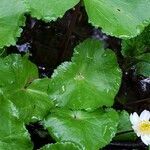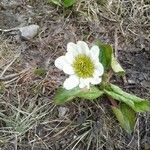A herb. It keeps growing from year to year. It has a short erect rootstock. It grows 30 cm high and spreads 30 cm wide. The leaves are fleshy and heart-shaped. The flowers occur singly and are silvery white. They are on leafless stalks which stick up above the leaves. The fruiting heads are shaped like a top and contain several pods which contain many seeds.



